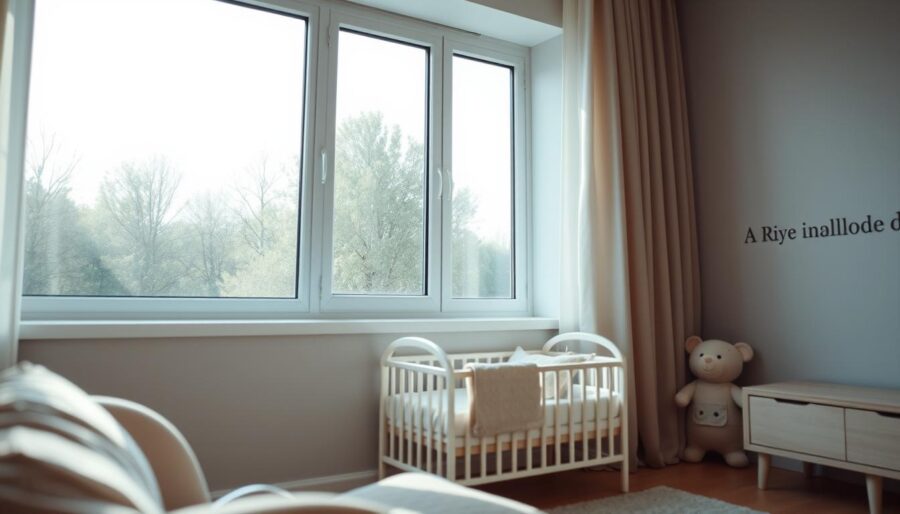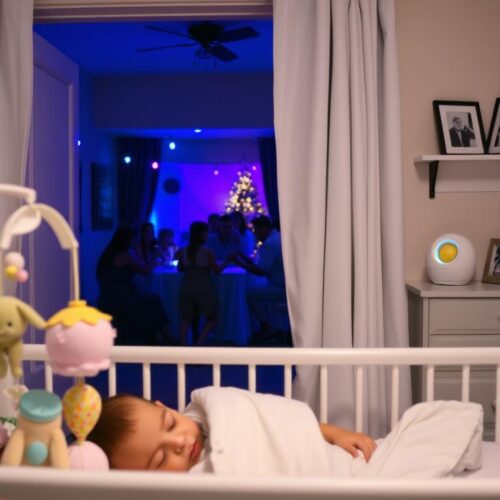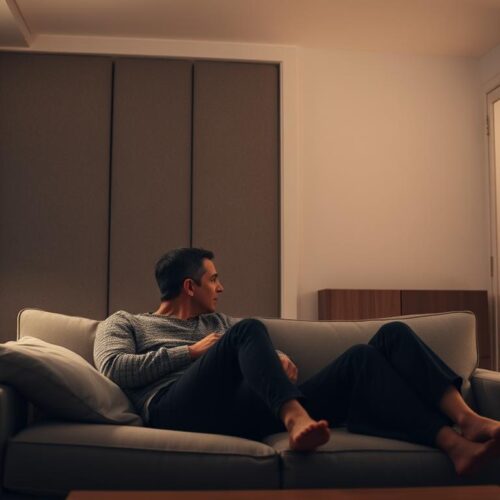Making a calm space for your baby begins with setting up the right surroundings. This means making sure window sealing is done well. Good acoustics in your baby’s room help them sleep peacefully and keep out loud, outside noises.
Using special techniques like soundproof window inserts and noise reduction seals on windows really helps. These methods cut down a lot of the unwanted noise. Parents should think about these soundproofing steps when planning the nursery. Doing so makes a quiet place that helps your baby feel comfortable.
Understanding the Importance of Acoustics in Baby Rooms
Creating a peaceful space for your baby is key. Acoustics play a big role in this. Because babies are very sensitive to noise, too much can upset them or mess up their sleep. Good acoustics make a nursery calmer, helping your baby sleep better.
Soundproofing your baby’s room brings about a quiet area. It helps them relax and sleep without interruptions. Outside noises like cars, construction, or household sounds can disturb their sleep. Making the room quiet can be a big help.
A room with good acoustics creates a soothing environment. It makes your baby feel safe. The right sound environment is critical for your baby’s health and growth. It leads to peaceful nights and joy-filled days for your baby.
Why Soundproofing is Essential for Your Baby’s Sleep
Creating a perfect sleep space for your baby is more than just comfy bedding. Good soundproofing is key to making sure your baby sleeps without being interrupted. Studies show that a quiet room helps babies sleep longer which is great for their growth.
Outside noises can wake your baby, breaking their sleep pattern. This can make them fussy and irritable.
It’s not just about keeping babies comfortable. The sounds a baby hears can impact their brain and emotions. Making their room a quiet, calm place helps them sleep deeply.
Soundproofing isn’t just a fancy addition. It’s important for your baby’s health and happiness. By blocking out noise, you create a peaceful space. This helps your baby sleep well and grow up strong.
Types of Noise Disrupting Baby Rooms
It’s key to know the different noises that can disturb a baby’s sleep. There are common noises that cause trouble:
- Traffic Sounds: Constant honks and engine noises can penetrate walls, disturbing both babies and parents.
- Construction Noise: Renovations or building projects nearby can lead to unexpected jolts, making it difficult for babies to settle.
- Barking Dogs: Pets often create unanticipated external sound sources that can easily wake a sleeping child.
- Loud Neighbors: Voices or music from adjacent units can blur the lines of privacy, leading to sleepless nights.
Finding out what noises disrupt sleep helps us understand their effects.
Parents often share how noises, like a barking dog or traffic, wake them up. This increases stress at night. To solve this, you might need to soundproof the room. This helps create a calmer space for you and your baby.
Benefits of Acoustic Window Sealing
Understanding how acoustic window sealing helps can make your baby’s room a quiet place. This method cuts down on noise, making it easier for your baby to sleep well. It ensures outside sounds, like traffic or loud neighbors, are kept low.
Acoustic window sealing also saves on energy. It stops drafts and air leaks. This keeps the room’s temperature just right for your baby. It offers sound insulation and keeps energy costs down, a win-win for parents.
This choice leads to better sleep for your baby. Babies need a calm place to sleep just like we do. With proper soundproof windows, your baby’s room will be peaceful. This helps their mood and growth by keeping the room comfortable and quiet.
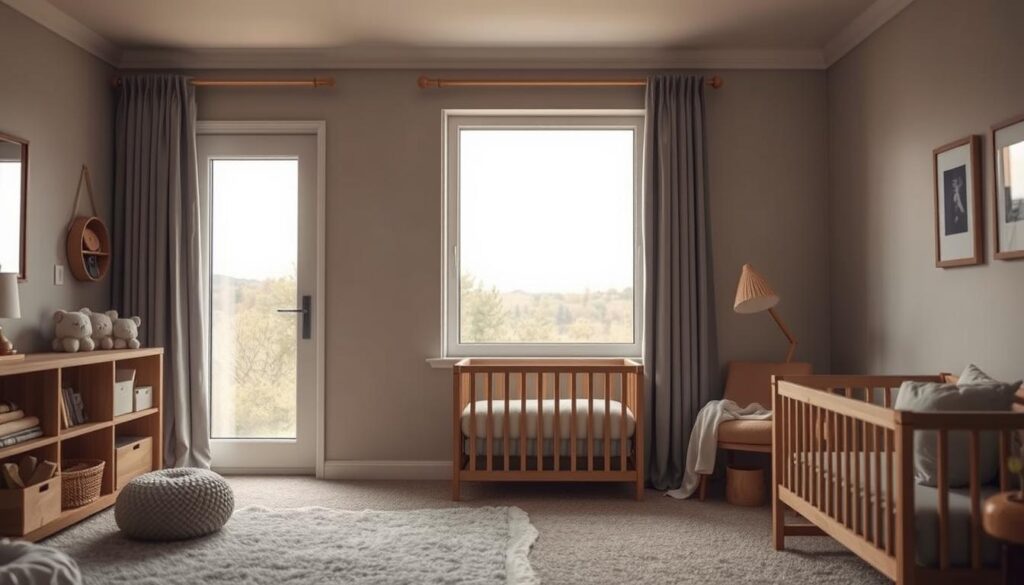
Effective Techniques for Window Soundproofing
Making your baby’s room quieter is important. Using the right window soundproofing techniques can help a lot. These methods decrease outside noise, giving your little one a calm place to rest.
Using Sound-Dampening Curtains
Heavy curtains, like those made from velvet or suede, can really cut down on outside noise. Installing these curtains correctly increases how well they work. They absorb and dampen sound. Pick curtains with a thick weave for the best noise blocking.
Applying Acoustic Caulk to Window Frames
Acoustic caulk is great for sealing small gaps in window frames. This type of sealant improves soundproofing by filling in cracks. It stops sound from getting through, making the room quieter for your baby.
Installing Window Inserts for Enhanced Sealing
Window inserts add an extra layer against noise. The space between the insert and the window helps absorb sound, making the room quieter. They’re a smart choice for better window soundproofing.
| Technique | Description | Benefits |
|---|---|---|
| Sound-Dampening Curtains | Heavyweight fabric curtains that absorb noise. | Reduces outside sounds, enhances privacy. |
| Acoustic Caulk | Seals small gaps in window frames for better insulation. | Prevents sound leakage, flexible application. |
| Window Inserts | Custom-fitted barriers that create air gaps. | Significant noise reduction, efficient insulation. |
Choosing the Right Materials for Acoustic Isolation
Choosing the best acoustic isolation materials is key to better sound in your baby’s room. Knowing the pros and cons of various options helps you make smart decisions.
Comparing Acoustic Foam and Heavy Drapes
Acoustic foam and heavy drapes both play roles in making a room quieter. Acoustic foam absorbs sound well, cutting down on echo and reverberation. Its design helps break up sound waves, creating calmness.
Heavy drapes are great at stopping outside noise. They work as a shield against traffic and other noise.
| Material | Sound Absorption | Noise Blocking | Cost |
|---|---|---|---|
| Acoustic Foam | High | Low | Moderate |
| Heavy Drapes | Moderate | High | Variable |
Utilizing Weatherstripping for Gaps
Windows with gaps can let a lot of sound through, hurting your soundproofing efforts. Weatherstripping is an affordable fix that seals these gaps, blocking sound and air from escaping. Adding it improves the sound quality and energy efficiency of your place.
How Soundproofing Windows Contributes to Energy Efficiency
Soundproofing your home brings more than just peace and quiet. It plays a big role in saving energy too. By sealing your windows well, you reduce outside noise and keep your home warm or cool. This means you can save a lot on your energy bills.
Putting in soundproof windows or extra insulation helps keep the warm or cool air inside. This makes it easier to control your home’s temperature. As a result, your heating and cooling system doesn’t have to work as hard. You’ll see lower energy bills and enjoy more comfort.
Soundproofing does more than just make your home quieter. For instance, windows with multiple panes don’t just block noise. They also keep your home’s temperature steady. This two-in-one benefit means your home is more energy-efficient, helping you save money in the long run.
Let’s look at different soundproofing options and see how they help save energy:
| Soundproofing Option | Noise Reduction (dB) | Thermal Insulation (R-value) | Energy Savings Potential (%) |
|---|---|---|---|
| Single-pane Windows | 20 | 1.0 | 10 |
| Double-pane Windows | 30 | 2.0 | 20 |
| Multi-pane Windows | 40 | 3.0 | 30 |
Choosing the right window soundproofing can make your home quieter and more energy-efficient. Soundproofing and thermal insulation work together to keep your home comfy. At the same time, they help you save on energy costs.
DIY vs Professional Installation of Soundproofing Solutions
Deciding if you should soundproof windows yourself or hire pros is important. Each way has its benefits. Learning which is best for you helps make your soundproofing better. Here are tips and a guide for those who like to do things themselves.
Steps for a DIY Window Sealing Project
- Look at your windows for any gaps or leaks. Check around the frames and sills carefully.
- Get materials like acoustic caulk, weatherstripping, and soundproof curtains.
- Clean the window frames well so the sealing materials stick better.
- Use acoustic caulk to fill any gaps around the window frames.
- Put weatherstripping around the window edges to improve the seal.
- Add sound-dampening curtains for even less noise.
When to Call Sound Isolation Services
DIY soundproofing works well sometimes, but there are times you might need experts. Think about professional help when:
- You’re facing a very tricky window sealing project.
- Your own efforts don’t cut down the noise much.
- You need special materials or methods you’re not sure about.
- You have to soundproof many areas, needing a bigger plan.
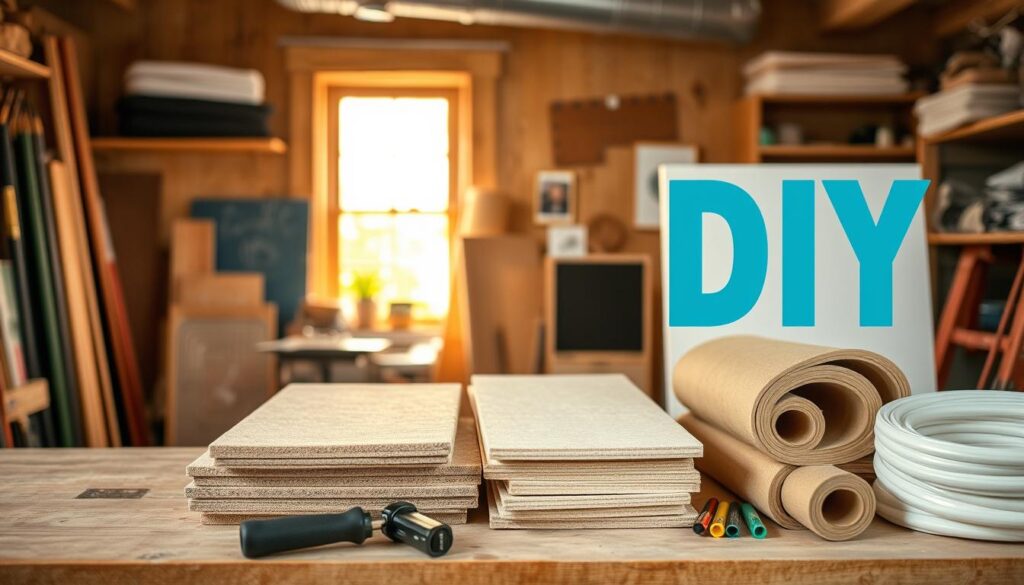
Combining Acoustic Solutions for Optimal Results
To create a space that absorbs noise and feels comfy, it’s smart to use a mix of soundproofing methods. This way, the space becomes calm and quiet. Combining different strategies boosts the power of each one and tackles more sound problems at once.
Acoustic panels work great with window sealing to catch more sound. They lower echoes and make the room quieter, perfect for when your baby sleeps. Placing them correctly helps a lot in cutting down noise.
Using Acoustic Panels in Tandem with Window Sealing
Combining acoustic panels with window sealing is very effective. The sealing keeps outside noise out, and the panels trap noise inside from bouncing around. This duo works together to keep the room peaceful, helping your baby sleep better.
Integrating Other Soundproofing Solutions
Besides panels and windows, adding floor rugs and special wall treatments can help even more. These extra steps build on your main soundproofing plans. By covering all bases, you turn your home into a peaceful place that lets your child rest without noise.
Evaluating the Costs of Soundproofing Products
When looking into soundproofing for your baby’s room, it’s key to think about the cost. Prices can change a lot. They depend on the materials, how well you want it to work, and if you’ll do it yourself or hire someone. Planning your budget means looking at all the choices you have.
Some wallet-friendly picks are sound-dampening curtains and acoustic caulk. They usually cost less than big projects like acoustic panels or window inserts. The cost of soundproofing varies. Simple DIY stuff can start at $50. But paying for professional help can go over $1,000, depending on what you’re doing.
Here’s a table to help you see the differences in soundproofing options and what they cost:
| Soundproofing Solution | Estimated Cost | Description |
|---|---|---|
| Sound-Dampening Curtains | $50 – $200 | Easy to install and effective in reducing outside noise. |
| Acoustic Caulk | $10 – $30 | Used to seal gaps around windows and doors for better acoustics. |
| Window Inserts | $200 – $500 | Provide significant noise reduction and energy efficiency. |
| Acoustic Panels | $100 – $400 | Absorbs sound waves, reducing echo and noise levels. |
| Professional Installation | $500 – $1,500 | Comprehensive service offering expert assessment and installation. |
Knowing these costs helps you choose what’s best for soundproofing your home. Investing wisely now means your baby might sleep better. And your home will be quieter. It’s all about planning with your needs and budget in mind.
Common Misconceptions About Soundproofing Baby Rooms
Many people believe myths about making baby rooms quieter. One major myth is the high cost of soundproofing. But, there are many affordable ways to lessen noise. Using simple methods like weatherstripping or adding sound-dampening curtains can make a big difference without costing a lot.
Some think heavy remodeling is needed to soundproof a room. They believe they must change walls or windows. This isn’t the case. Small changes can greatly improve room acoustics. Just using acoustic caulk or hanging thick curtains can help a lot. And you won’t need to deal with a big mess or big renovations.
These myths can make new parents unsure about seeking soundproofing options. Knowing the truth helps you create a peaceful space for your baby. Look into soundproofing choices that fit your budget and needs.
Conclusion
Keeping your baby’s room quiet is very important. By using window seals for soundproofing, you can block out loud noises. This helps your baby sleep better. Window sealing includes using special curtains and getting expert help to make a peaceful room for your baby.
If you’re thinking about making your home quieter, start now. You can try doing it yourself or get professional help. Every step you take helps make your home more peaceful. This is very important for your child to grow and be happy.
By keeping your home quiet, your baby will sleep better. This makes your home a nicer place for everyone. Working to have a quiet space has great benefits. It helps your baby be happy and healthy.

